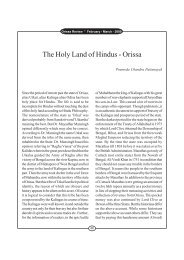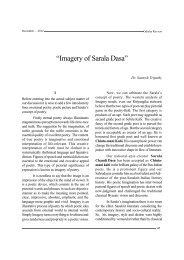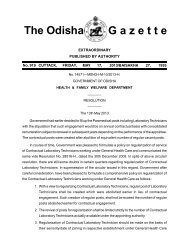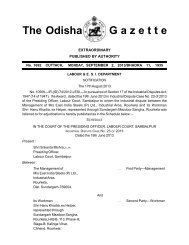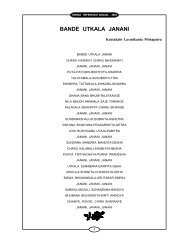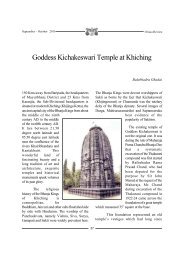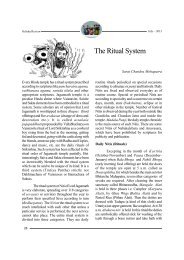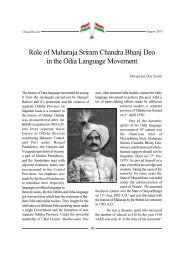Devi Cult in medieval Hinduism & Jainism
Devi Cult in medieval Hinduism & Jainism
Devi Cult in medieval Hinduism & Jainism
You also want an ePaper? Increase the reach of your titles
YUMPU automatically turns print PDFs into web optimized ePapers that Google loves.
PDF<br />
Documents<br />
Complete<br />
Click Here & Upgrade<br />
Expanded Features<br />
Unlimited Pages<br />
In Somdeva's Yasastilaka the most important is,<br />
of course, that of Candamari which forms the<br />
start<strong>in</strong>g po<strong>in</strong>t of the matter among the non-Ja<strong>in</strong><br />
cult. Human sacrifice was an essential feature of<br />
the worship of that goddess. To some extent it is<br />
gruesome and fantastic. There was another form<br />
of Chandika <strong>in</strong> the tenth century A.D. as is evident<br />
from the descriptions of the devi and the blood<br />
sta<strong>in</strong>ed temple <strong>in</strong> works like Kadambari of Bana,<br />
the great writer of repute and Haribhadra's<br />
Sumaraiccakaha. The Deity is called also<br />
Katyayani and Kadambari. In his work<br />
Vasavadatta, Subandhu refers to the shr<strong>in</strong>e of<br />
Katyayani while narrat<strong>in</strong>g the city of Kusumapura<br />
which was otherwise known as Pataliputra. In<br />
Malatimadhava the goddess appears as Karala<br />
or Chamunda to whom a human victim is to be<br />
offered by a Kapalika <strong>in</strong> accordance with the<br />
great Bhavabhuti. She appears as V<strong>in</strong>dhyas<strong>in</strong>i to<br />
whom lengthy hymn is addressed by Yasovarman<br />
<strong>in</strong> Gandavaho of Vakpati. The Goddess is also<br />
called as Narayani, Sabari and Chandi.<br />
Among other th<strong>in</strong>gs, sacrifice of the<br />
human victim and the custom of sell<strong>in</strong>g human flesh<br />
as depicted <strong>in</strong> the hymn <strong>in</strong> question is really<br />
gruesome and horrible. In another context<br />
Harsacharita of Bana refers to the burn<strong>in</strong>g of<br />
Guggulu res<strong>in</strong> on the head while supplicat<strong>in</strong>g the<br />
Orissa Review * September - October - 2005<br />
<strong>Devi</strong> <strong>Cult</strong> <strong>in</strong> Medieval H<strong>in</strong>duism and Ja<strong>in</strong>ism<br />
35<br />
Dr. Gouri Shankar Tripathy<br />
A Ja<strong>in</strong> writer of tenth century Somadeva had referred to the <strong>Cult</strong> of Chandika. In his<br />
Bhabasamgraha, Devasena, a few decades earlier, mentioned about the kill<strong>in</strong>g of goats at<br />
the altar of Chandika.<br />
Mahakala Siva and the offer<strong>in</strong>g of flesh cut out of<br />
one's own body as an oblation <strong>in</strong> the fire which is<br />
the self torture as described by Somdeva as be<strong>in</strong>g<br />
practised by certa<strong>in</strong> fanatics <strong>in</strong> the temple of<br />
Candamari. The offer<strong>in</strong>g of slices of one's own<br />
flesh to the devi has bean mentioned <strong>in</strong><br />
Kuvalayamala composed by Uddyatana <strong>in</strong> the<br />
eighth century A.D. In the seventh century A.D.<br />
the Ch<strong>in</strong>ese traveller Yuan Chwang visited a temple<br />
at Prayag where certa<strong>in</strong> devotees committed<br />
suicide <strong>in</strong> the hope of ga<strong>in</strong><strong>in</strong>g the Swarga of the<br />
gods.<br />
On the island of Mandhata <strong>in</strong> the<br />
Narmada situated <strong>in</strong> the Nirmar district of the then<br />
Central Prov<strong>in</strong>ce, a similar practice was<br />
prevail<strong>in</strong>g. At the eastern end of the island over<br />
the rocks of the river br<strong>in</strong>k, the terrible god Kala<br />
Bhairav resided where the devotees until recent<br />
times were <strong>in</strong> the habit of dash<strong>in</strong>g themselves on<br />
the Birkhala cliffs. In 1824, the last such offer<strong>in</strong>g<br />
to Kala Bhairava was witnessed. In Somadeva's<br />
Yasastilaka the shr<strong>in</strong>e of Chandamari is called<br />
Mahabhairava which is really significant. A<br />
Chauhan Rajput named Bharat S<strong>in</strong>gh took<br />
Mandhata from Nathu Bhil <strong>in</strong> 1165 A.D. It is said<br />
that a priest named Daryao Nath used to worship<br />
Omkar Shiva on the island for the protection of<br />
the pilgrims. As the legend goes, that Daryao Nath
PDF<br />
Documents<br />
Complete<br />
Click Here & Upgrade<br />
Expanded Features<br />
Unlimited Pages<br />
by his austerities shut up Kali <strong>Devi</strong>, the consort<br />
of Kala Bhairava who fed on human flesh <strong>in</strong> a<br />
cave. The mouth of the cave is still shown to the<br />
pilgrims visit<strong>in</strong>g the place. For of the worship of<br />
Omkar Siva, the disciples of Daryao Nath still<br />
enjoy landed property allotted to them. In these<br />
traditional accounts it is difficult to separate fact<br />
from fiction. Evidently at a later time, an abnormal<br />
k<strong>in</strong>d of tantric cult seems to have developed <strong>in</strong><br />
Mandhata. This is "Bamamarga" as narrated <strong>in</strong><br />
Yasastilaka of Somadeva which is a debased<br />
type of Saivism.<br />
From about the seventh century onwards<br />
it seems to have been widely prevalent as the <strong>Devi</strong><br />
came to be known by different names such as<br />
Chandika, Katyayani, Bhavani, Durga etc. The<br />
Shakti worship must be dist<strong>in</strong>guished from the<br />
abnormal ritual mentioned by Somedeva <strong>in</strong> his<br />
Yasastilaka as is ord<strong>in</strong>arily practised. About 64<br />
kms south of Chennai there are two rock-cut<br />
temples dedicated to Sri Durga at Mamallapuram<br />
now known as Mahabalipuram. Out of the two<br />
temples on the sea-coast one is known as Kotikal<br />
Mandap and the other one is Draupadi Rath.<br />
Kotikal Mandap is a primitive-look<strong>in</strong>g shr<strong>in</strong>e<br />
consist<strong>in</strong>g of a hall of size 22 feet long and 8 feet<br />
width. Draupadi Rath is a beautifully carved shr<strong>in</strong>e<br />
with a domical roof with a figure of Durga <strong>in</strong>side.<br />
There is a huge rock-cut figure of Durga's<br />
vehicle, the ferocious lion, carved <strong>in</strong> front of the<br />
temple. Near the temple fac<strong>in</strong>g the sea, a number<br />
of crudely fashioned figures of the goddess and<br />
her vehicle lion are also carved on some of the<br />
isolated rocks. The figure of Durga is four-armed<br />
<strong>in</strong> the so-called Draupadi Rath. It has been<br />
portrayed stand<strong>in</strong>g on a lotus pedestal with two<br />
worshippers kneel<strong>in</strong>g at her feet. In one of the<br />
large panels of the walls of the temple known as<br />
the Varahamandapa, these features are also seen<br />
<strong>in</strong> the representation of the goddess. The goddess<br />
with eight arms, trampl<strong>in</strong>g on the head of a buffalo<br />
occurs on the facade of the Trimurti temple <strong>in</strong> a<br />
panel. Not only <strong>in</strong> India but <strong>in</strong> Java also, the story<br />
of Durga slay<strong>in</strong>g the buffalo demon is popular. A<br />
remarkable fight of the goddess with the demon<br />
Orissa Review * September - October - 2005<br />
36<br />
has been regarded as one of the f<strong>in</strong>est specimens<br />
of India as found <strong>in</strong> the so-called<br />
Mahisasuramandapa.<br />
On a much smaller scale, <strong>in</strong> a beautiful<br />
panel discovered near the Siva temple at Bhumara<br />
of the early Gupta - period a wonderful scene is<br />
represented the goddess is four-armed, where<br />
with a sword <strong>in</strong> one hand and a trident <strong>in</strong> another,<br />
putt<strong>in</strong>g the left foot on the head of the Buffalo and<br />
grasps his tail with one of her hands.<br />
One of the worshippers is shown as<br />
cutt<strong>in</strong>g off the tresses of his hair with a sword as a<br />
votive offer<strong>in</strong>g to the goddess <strong>in</strong> Draupadi Rath<br />
which is quite noteworthy. As described by<br />
Somadeva and others, such practices are, of<br />
course, far different from the various forms of selftorture,<br />
practised <strong>in</strong> connection with the cult of<br />
Candamari or Chandika. In Yasastilaka, the<br />
practices narrated belong to an abnormal k<strong>in</strong>d of<br />
the cult appeal<strong>in</strong>g to the fanaticism of a limited<br />
class of worshippers.<br />
In later times, some of the old temples<br />
dedicated to <strong>Devi</strong> have been rebuilt. The temple<br />
of Amba Bhavani is an important centre of<br />
pillgrimage situated on the summit of the hills of<br />
Arasur at the south-western extremity of the<br />
Aravali range. It lays claim to a remote antiquity.<br />
About 32 kms to the south east of Baroda<br />
the ancient town of Dabhoi conta<strong>in</strong>s a temple<br />
dedicated to Bhadra Kalika Mata. To the right of<br />
the famous Hira Gate at Dabhoi on the east side<br />
of the old fort it is situated and stands <strong>in</strong> honour<br />
of the same goddess on the site of an older shr<strong>in</strong>e.<br />
Probably it was built around 1255 A.D. by<br />
Vishaldev Baghela. Of the monuments of the Pre-<br />
Muslim period <strong>in</strong> Gujarat, this temple is one of<br />
the most important architectural monuments. On<br />
the lofty summit of the hill of Pavagadh situated<br />
about 38 kms north east of Baroda, another <strong>Devi</strong><br />
temple known as Kalika Mata stands <strong>in</strong> glory.<br />
For many centuries as the guardian deity of the<br />
hills, the goddess has been worshipped on the<br />
rocky peak. As a place of pilgrimage developed<br />
under the rulers of Anhilvad Patan the shr<strong>in</strong>e is
PDF<br />
Documents<br />
Complete<br />
Click Here & Upgrade<br />
Expanded Features<br />
Unlimited Pages<br />
visible from a distance of many miles <strong>in</strong> the pla<strong>in</strong><br />
below and is no doubt very ancient. In the Garoth<br />
district of M.P., an ancient temple of <strong>Devi</strong> exist at<br />
the small village of Antri which is venerated by<br />
Rajputs throughout Malwa and Mewar. With the<br />
materials collected from the ru<strong>in</strong>s of an older<br />
shr<strong>in</strong>e, the present temple is built <strong>in</strong> a modern<br />
structure.<br />
A couple of miles from the frontier of<br />
Hyderabad, and six miles east of Kajgaon station<br />
<strong>in</strong> the east Khandesh district a small temple<br />
dedicated to the god Sambhu is built outside the<br />
village Dighi. The sanctum conta<strong>in</strong>s a small L<strong>in</strong>ga<br />
and a large stand<strong>in</strong>g image of <strong>Devi</strong>. A niche on<br />
the north wall of the Mandap conta<strong>in</strong>s a danc<strong>in</strong>g<br />
figure of Chamunda. In an emaciated body she<br />
has four hands. She holds a trident, a skull-mace<br />
and a skull cup <strong>in</strong> her three hands.<br />
A small rev<strong>in</strong>e on the north bank of the<br />
Narmada, very close to the island of Mandhata<br />
is popularly known as the Rawna Nala which<br />
conta<strong>in</strong>s a figure stretched out on the ground fac<strong>in</strong>g<br />
downward and is 18 feet <strong>in</strong> length. It is crudely<br />
carved <strong>in</strong> bold relief on four basalt slabs laid, end<br />
Orissa Review * September - October - 2005<br />
37<br />
to end. It has one head, ten arms all hold<strong>in</strong>g clubs<br />
and wear<strong>in</strong>g pendents of skulls. There is a<br />
scorpion on its chest and a rat on its right side,<br />
while one foot rest on a smaller prostrate human<br />
figure. This huge image no doubt represents<br />
Chamunda or Mahakali. It was evidently <strong>in</strong>tended<br />
to be placed <strong>in</strong> a colossal temple which was never<br />
completed. With huge basalt salt rocks, slightly<br />
curved <strong>in</strong> some places, the entire bed of the rev<strong>in</strong>e<br />
is covered.<br />
In different parts of India, temples of<br />
Durga appear to have been built dur<strong>in</strong>g the<br />
<strong>medieval</strong> period. Four miles to the north of Kal<strong>in</strong>ga<br />
Pattanam <strong>in</strong> the then Ganjam District, an<br />
<strong>in</strong>scription was discovered <strong>in</strong> the village Dirghasi<br />
which records the erection of a Mandap <strong>in</strong> front<br />
of the Durga temple at Dirghasi by a Brahm<strong>in</strong><br />
Chiefta<strong>in</strong> named Ganapati who was <strong>in</strong> the service<br />
of the eastern Ganga k<strong>in</strong>g Raja Raja I of Orissa.<br />
Dr. Gourishankar Tripathy lives at 847, Kapil Prasad,<br />
P.O. Sundarpada, Bhubaneswar- 751002.<br />
Information & Public Relations Department, Kolkata Office organised Debate<br />
Competition among the Oriya High School Students and prizes with certificates<br />
were awarded to them on the occasion of Independence Day - 2005 at Kolkata.<br />
Shri Saidutta Biplab Kumar Pradhan, Manager Utkal Bhawan distribut<strong>in</strong>g the<br />
prizes.




